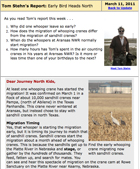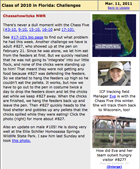The first cranes from both migratory flocks are northward bound! Learn how to tell a Whooping crane from other big black-and-white birds. Does our image of the week show a Whooping crane? Meet Al and Diane, the Western flock’s most productive pair.
Today's Report Includes:
- News: Migration Map and Field Reports
- Activity: Log the Eastern Flock Arrivals
- Lesson: Big, Black-and-White Birds
- Slideshow: Al and Diane, Most Productive Pair
- Quick Links: Helpful Resources to Explore
 Photo:
Jeannette Parker
Photo:
Jeannette Parker
Cranes are
migrating! Is
this a whooping crane?
Learn tips to ID whoopers this week!
 |
||
|
Migration
is underway! |
Latest
News! The Western (natural) Flock in Texas: Tom explains why one whooper left Texas so early, and why he hopes he's had his last fight to count the cranes. |
Latest
News! |
|
All the youngest crane-kids are still at their Florida release sites, but Whooping crane migration has begun! Just one early bird from the western flock is migrating, but at least 25 older cranes in the eastern flock are on the journey north. Early birds #904 and #416 were back on the Wisconsin nesting grounds on March 9! Migrating cranes include the family with W3-10, now in Indiana. March 8 was a big departure day from Florida, with five cranes apparently starting migration. We'll add new sightings to the map as they are confirmed. Go cranes! |
||
The Eastern flock is on the move. One amazing pair has completed migration to Wisconsin already!
Join the tracking crew and keep your own inventory of cranes as they reach the finish line in Wisconsin.
Download your Arrival Log for the Eastern Flock and enter the first arrivals.
How exciting to know that endangered Whooping cranes are in the migration flyways! WCEP and Journey North want to hear from you if you see them. But how can you be sure you saw a Whooping crane?
Correct identification can be tricky, but it's fun to be a detective and look for the clues. This week's report is full of tips to train your eyes.
See this slideshow to sharpen your observation skills — and keep looking up now that migration has begun.
We don't know as many details about the lives of the wild natural flock (the Western flock) as we do about the captive-born ultralight-led flock. But biologist Tom Stehn's memory is full of wonderful stories about the cranes he's come to know over the past 30 years as a leader of the Whooping Crane Recovery Team. Meet the crane pair Al and Diane and see why they're so great. Then write in your journal:
- In 18 nesting attempts between 1993 and 2010, Al and Diane have brought young to Aransas NWR ___ times. They have brought __ single chicks and __ sets of twins. They have brought a total of __ chicks to the Texas wintering grounds.
- What did you discover to help explain why the crane population grows so slowly?
How many chicks have Al and Diane brought to Aransas NWR since they became mates in 1993?
- Lesson and Handouts: Making a Map of Whooping Crane Habitat
- Activity: Arrival Log for Eastern Flock
- Slideshow: Crane ID: Will You Know A Whooper?
- Practice: Were They Whoopers? You Be the Judge
- Report Right: How to Report a Whooping Crane Sighting
- Teachers/Overview: Getting Started
The Next Whooping Crane Migration Update Will Be Posted on March 25, 2011.








